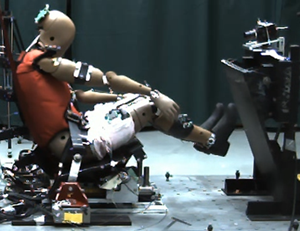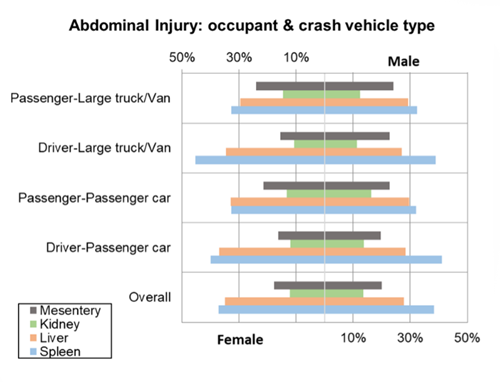Ongoing Research from the Trauma Biomechanics Lab

Impact and Injury Response of the Occupant in Automated Driving Vehicles
 The Trauma Biomechanics Laboratory employs a combined experimental and computational approach to study occupant injuries during frontal crash scenarios in alternative seating conditions. This research explores the effects of varied external variables such as crash severity on the likelihood of submarining the lap belt, analyzes thoracic injury patterns, and develops injury risk curves.
The Trauma Biomechanics Laboratory employs a combined experimental and computational approach to study occupant injuries during frontal crash scenarios in alternative seating conditions. This research explores the effects of varied external variables such as crash severity on the likelihood of submarining the lap belt, analyzes thoracic injury patterns, and develops injury risk curves. Representative Publications
- Obese Occupant Response in Reclined and Upright Seated Postures in Frontal Impacts
- Small Female Occupant Response in Reclined and Upright Seated Postures in Frontal Impacts
- Analysis of experimental injuries to obese occupants with different postures in frontal impact
- THOR-05F biofidelity evaluation in reclined and upright seated postures subjected to frontal crash pulses
Image Description
The above image shows the kinematics of a female dummy subjected to frontal impact.Real-World Crash Database Review

The Trauma Biomechanics Laboratory collaborates with clinicians and researchers at MCW on motor vehicle crash database review studies. These include analyses of clinical databases such as the NTDB and MCW's CRDW, as well as crash databases like CISS and CIREN. Current research focuses on trends in abdominal and pelvic injuries and investigates sex-associated disparities in injury outcomes.
Representative Publications
- Sex-related disparities in vehicle crash injury and hemodynamics
- Sex-Based Abdominal Injury Disparities in Motor Vehicle Crash Injuries: A Clinical Review
Image Description
The bar chart above presents the weighted frequency of key abdominal injuries among males and females associated with motor vehicle crashes, based on data extracted from the National Trauma Data Bank (2018-2021).
Biomedical Model and Spinal Trauma

The Trauma Biomechanics Laboratory collaborates with other investigators at the Medical College of Wisconsin's ZVAMC Labs on studies to delineate injury mechanisms and establish human tolerance thresholds. Projects include assessments of aircraft seat configurations, spinal trauma biomechanics, and human surrogate response to vertical loading. A notable achievement of this collaboration is the development of a tension-bending combined injury criterion for the lumbar spine of the FAA-HIII dummy, which has been incorporated into recommended assessment criteria for oblique aircraft seat performance.
Representative Publications
- Occupant injury and response on oblique-facing aircraft seats: a computational study
- Tension-bending risk curves for the ATD lower lumbar spine subjected to oblique impact under FAA emergency landing conditions
- Evaluating thoracolumbar spine response during simulated underbody blast impact using a total human body finite element model
- Mechanisms of timing of injury to the thoracic, lumbar and sacral spine in simulated underbody blast PMHS impact tests
- An experimental and numerical study of Hybrid III dummy response to simulated underbody blast impacts
- Cervical spine degeneration specific segmental angular rotational and displacements: A quantitative study
- Importance of neural foraminal narrowing in lumbar spine fractures of low AIS severity
Image Description
Top: Kinematics comparison between PMHS (Post-Mortem Human Subjects) and a human body model subjected to an oblique impact with an aircraft emergency crash pulse
Bottom: Survival analysis-based injury risk curve with +/- 95% confidence intervals (dashed lines) for the lower lumbar spine of the FAA-H3 dummy evaluated under oblique loading.

